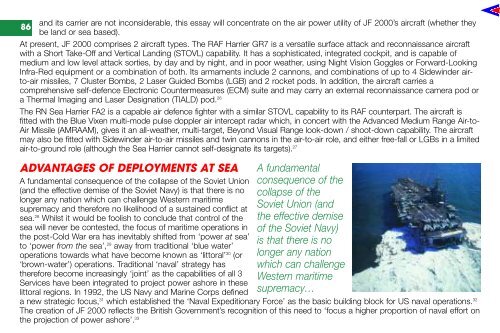THE RAF AIR POWER REVIEW - Royal Air Force Centre for Air ...
THE RAF AIR POWER REVIEW - Royal Air Force Centre for Air ...
THE RAF AIR POWER REVIEW - Royal Air Force Centre for Air ...
Create successful ePaper yourself
Turn your PDF publications into a flip-book with our unique Google optimized e-Paper software.
and its carrier are not inconsiderable, this essay will concentrate on the air power utility of JF 2000’s aircraft (whether they<br />
86<br />
be land or sea based).<br />
At present, JF 2000 comprises 2 aircraft types. The <strong>RAF</strong> Harrier GR7 is a versatile surface attack and reconnaissance aircraft<br />
with a Short Take-Off and Vertical Landing (STOVL) capability. It has a sophisticated, integrated cockpit, and is capable of<br />
medium and low level attack sorties, by day and by night, and in poor weather, using Night Vision Goggles or Forward-Looking<br />
Infra-Red equipment or a combination of both. Its armaments include 2 cannons, and combinations of up to 4 Sidewinder airto-air<br />
missiles, 7 Cluster Bombs, 2 Laser Guided Bombs (LGB) and 2 rocket pods. In addition, the aircraft carries a<br />
comprehensive self-defence Electronic Countermeasures (ECM) suite and may carry an external reconnaissance camera pod or<br />
a Thermal Imaging and Laser Designation (TIALD) pod. 26<br />
The RN Sea Harrier FA2 is a capable air defence fighter with a similar STOVL capability to its <strong>RAF</strong> counterpart. The aircraft is<br />
fitted with the Blue Vixen multi-mode pulse doppler air intercept radar which, in concert with the Advanced Medium Range <strong>Air</strong>-to-<br />
<strong>Air</strong> Missile (AMRAAM), gives it an all-weather, multi-target, Beyond Visual Range look-down / shoot-down capability. The aircraft<br />
may also be fitted with Sidewinder air-to-air missiles and twin cannons in the air-to-air role, and either free-fall or LGBs in a limited<br />
air-to-ground role (although the Sea Harrier cannot self-designate its targets). 27<br />
ADVANTAGES OF DEPLOYMENTS AT SEA<br />
A fundamental consequence of the collapse of the Soviet Union<br />
(and the effective demise of the Soviet Navy) is that there is no<br />
longer any nation which can challenge Western maritime<br />
supremacy and there<strong>for</strong>e no likelihood of a sustained conflict at<br />
sea. 28 Whilst it would be foolish to conclude that control of the<br />
sea will never be contested, the focus of maritime operations in<br />
the post-Cold War era has inevitably shifted from ‘power at sea’<br />
to ‘power from the sea’, 29 away from traditional ‘blue water’<br />
operations towards what have become known as ‘littoral’ 30 (or<br />
‘brown-water’) operations. Traditional ‘naval’ strategy has<br />
there<strong>for</strong>e become increasingly ‘joint’ as the capabilities of all 3<br />
Services have been integrated to project power ashore in these<br />
littoral regions. In 1992, the US Navy and Marine Corps defined<br />
A fundamental<br />
consequence of the<br />
collapse of the<br />
Soviet Union (and<br />
the effective demise<br />
of the Soviet Navy)<br />
is that there is no<br />
longer any nation<br />
which can challenge<br />
Western maritime<br />
supremacy…<br />
a new strategic focus, 31 which established the ‘Naval Expeditionary <strong>Force</strong>’ as the basic building block <strong>for</strong> US naval operations. 32<br />
The creation of JF 2000 reflects the British Government’s recognition of this need to ‘focus a higher proportion of naval ef<strong>for</strong>t on<br />
the projection of power ashore’. 33

















